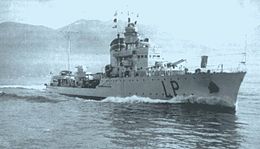Battle of the Tarigo Convoy
| Battle of the Tarigo Convoy | |||||||
|---|---|---|---|---|---|---|---|
| Part of the Battle of the Mediterranean of World War II | |||||||
 Destroyer Lampo, sunk in the battle and later salvaged by the Italian Navy |
|||||||
|
|||||||
| Belligerents | |||||||
|
|
|
||||||
| Commanders and leaders | |||||||
| Captain Philip Mack | Commander Pietro de Cristofaro † | ||||||
| Strength | |||||||
| 4 destroyers | 3 destroyers | ||||||
| Casualties and losses | |||||||
| 1 destroyer sunk 43 dead |
2 destroyers sunk 1 destroyer beached 5 cargo ships sunk or beached 350-1,800 dead |
||||||
The Battle of the Tarigo Convoy (sometimes referred to as the "Action off Sfax") was a naval battle of World War II, part of the Battle of the Mediterranean. It was fought on 16 April 1941, between four British and three Italian destroyers, near the Kerkennah Islands off the Tunisian coast. The battle was named after the Italian flagship, the destroyer Luca Tarigo.
Control of the sea between Italy and Libya was heavily disputed as both sides sought to safeguard their own convoys while interdicting those of their opponent. Axis convoys to North Africa supplied the German and Italian armies there, and British attacks were based on Malta, itself dependent upon convoys.
In mid-April, 1941, a five ship Axis convoy sailed from Naples, en route to Tripoli. It consisted of four German troopships (Adana, Arta, Aegina and Iserlohn) and an Italian ammunition ship (Sabaudia). The convoy was escorted by a "Navigatori" class destroyer Luca Tarigo (flagship) and two Folgore class destroyers, Baleno and Lampo, all commanded by Commander Pietro de Cristofaro. The convoy was delayed by bad weather, sailing in the evening of 13 April.
The British had been alerted to the convoy's sailing by intercepted radio messages. On 15 April, a British Maryland reconnaissance plane sighted and shadowed the convoy. Two Italian SM.79s that were ordered to provide air cover did not arrive, due to the continuing bad weather. During the night of 15–16 April, the convoy was intercepted by the British 14th Destroyer Flotilla (HMS Jervis (flagship), HMS Janus, HMS Nubian, and HMS Mohawk, commanded by Captain Philip Mack). At least three of these destroyers were equipped with radar. The encounter took place as the Italian convoy maneuvered around the shallow waters surrounding the Kerkennah Islands.
...
Wikipedia
